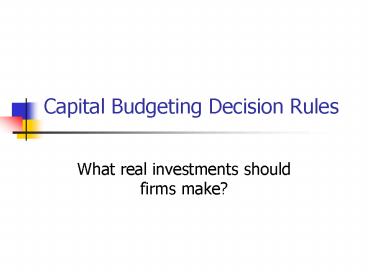Capital Budgeting Decision Rules - PowerPoint PPT Presentation
Title:
Capital Budgeting Decision Rules
Description:
Our work has shown that several criteria must be satisfied by any good decision rule: ... Tri Star Post Mortem. Accounting breakeven approximately 275 planes ... – PowerPoint PPT presentation
Number of Views:46
Avg rating:3.0/5.0
Title: Capital Budgeting Decision Rules
1
Capital Budgeting Decision Rules
- What real investments should firms make?
2
Alternative Rules in Use Today
- NPV
- IRR
- Profitability Index
- Payback Period
- Discounted Payback Period
- Accounting Rate of Return
3
What Provides Good Decision-Making?
- Our work has shown that several criteria must be
satisfied by any good decision rule - Decision rule should be based upon cash flow.
- The rule should incorporate all the incremental
cash flows attributable to the project. - The rule should discount cash flows appropriately
taking into account the time value of money and
properly adjusting for the risk inherent in the
project. - Opportunity cost of capital. - When forced to choose between projects, the
choice should be governed by maximizing
shareholder wealth given any relevant constraints.
4
NPV Analysis
- The recommended approach to any significant
capital budgeting decision is NPV analysis. - NPV PV of the incremental benefits PV of
the incremental costs. - NPV based decision rule
- When evaluating independent projects, take those
with positive NPVs, reject those with negative
NPVs. - When evaluating interdependent projects, take the
feasible combination with the highest combined
NPV.
5
Lockheed Tri-Star
- As an example of the use of NPV analysis we will
use the Lockheed Tri-Star case. - To examine the decision to invest in the Tri-Star
project, we first need to forecast the cash flows
associated with the Tri-Star project for a volume
of 210 planes. - Then we can ask What is a valid estimate of the
NPV of the Tri-Star project at a volume of 210
planes as of 1967.
6
Lockheed Tri-Star Key Points
- Pre-production costs estimated at 900 million
incurred between 1967 and 1971. - Total of 210 planes delivered from 1972-1977
- Revenues of 16 million per unit, 25 of revenue
received 2 years in advance of delivery. - Production costs of 14 million (at 210 units
could decline to 12.5 million at 300) from
1971-1976. - Discount rate of 10 per year.
7
Tri-Star Cash Flows
- 210 planes (1972-1977)
- Planes per year 210/635
- Production Costs (1971-1976)
- 35(14M)490M per year
- Dont forget the preproduction costs of 900M
- Revenues (1970-1977)
- Total Revenues 35(16M)560M per year
- Deposits0.25(560M)140M (2 yrs in advance)
- Net Revenues560-140420M on delivery
8
Tri-Star Cash Flows(210 Planes)
9
Tri-Star NPV _at_10 in 1967
10
Accounting Profits at 210
- Production revenues are 16M per plane and
production costs are 14M per plane. Profit is
2M per plane. - 2102M 420M production profits. 420M vs.
900M preproduction costs is breakeven? - Suppose production cost is 12.5M per plane
(learning curve hits early). Profit per plane is
3.5M. At 210 planes this is 735M production
profit. - Now take the extreme low-end of the 800M - 1B
preproduction cost range. - Suddenly you have breakeven. Smart huh?
11
Tri-Star NPV 1967 (Millions)
Units Sold Average Unit Cost Accounting Profit NPV
323 12.25 311 -195
400 12.00 700 -12
400 11.75 800 42
500 11.00 1,600 441
12
Tri-Star Cash Flows 1970(210 Planes)
13
1970 Tri-Star NPV _at_10
14
Tri Star Post Mortem
- Accounting breakeven approximately 275 planes
- 16M - 12.5M 3.5M per plane
- 3.5M?275 962M profit versus 960M in actual
development costs known in 1970 - This more realistic breakeven level announced
subsequent to the guarantees being granted. - NPV breakeven approximately 400 planes
- Total free world market demand for wide-body
aircraft approximately 325 planes - Optimistic estimate total demand 775 and 40 of
that is 310 - Lockheed share price
- 64 Jan 1967 drops to 11 Jan 1971
- (64-11)(11.3 Million shares)-599 Million
- Compare to -584 Million NPV































